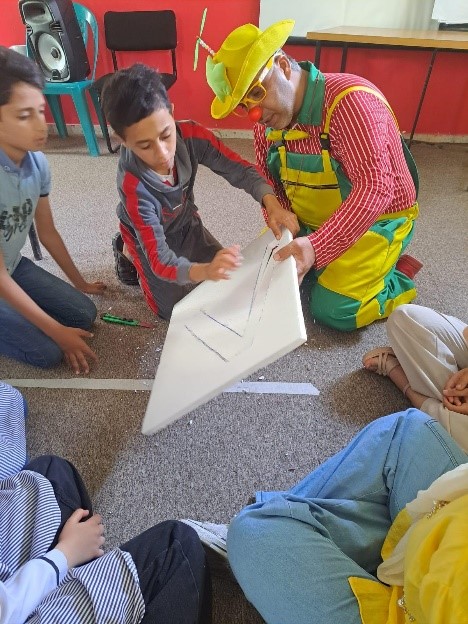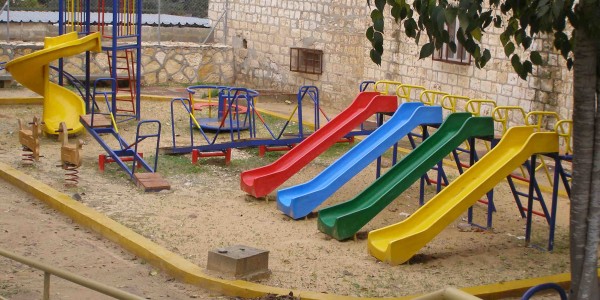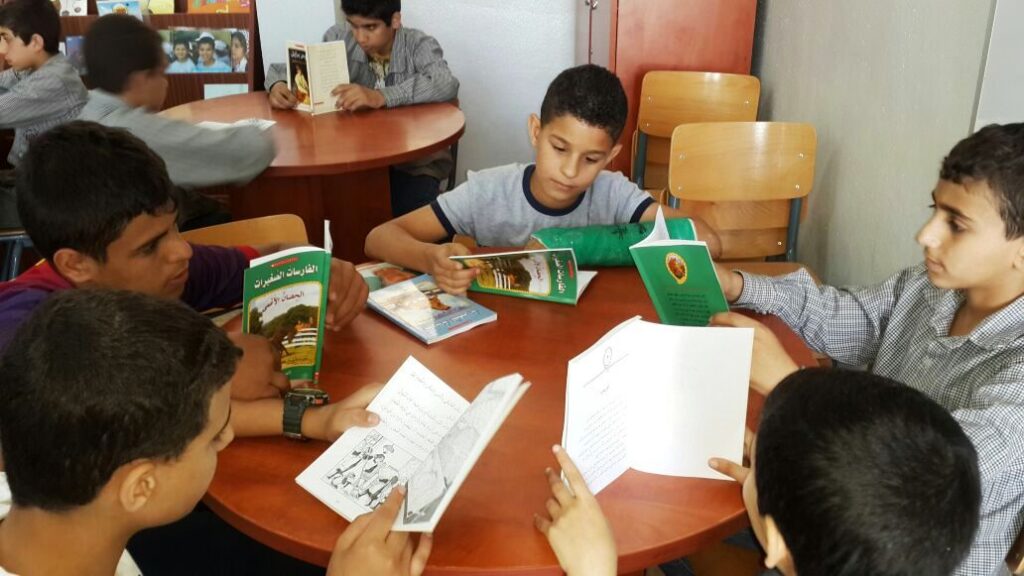Our Work
We build physical play spaces, offer learning opportunities, and provide trauma support for Palestinian children living in Gaza, the West Bank and Lebanon. Most of these children are denied the core rights of hope and play because of who they are, and where they live.
Emergency support to Gaza
The scale of what we are currently witnessing in Gaza is unfathomable.
Deliberate starvation on a mass scale.[1] Worse destruction than in World War Two; 70% of the north of Gaza obliterated. [2] Over 10,000 children killed[3], 17,000 children orphaned and alone.[4] 18,000 children injured.[5] Over 1,000 children are now amputees.[6] Everyone – young and old – is deeply traumatised by the past several months, and likely to suffer the after-effects for years to come.
Our focus is on emergency activities in Gaza, which we will continue to run until we are able to re-start our trauma programme and other regular activities. Read more about our Emergency Support to Gaza activities.
Trauma Support
Our flagship trauma programme in Gaza, Brighter Futures, has provided thousands of traumatised children with psychosocial and educational support, empowered parents on how to lessen the effects of cumulative trauma and strengthened community-based support mechanisms.
Even before this current Israeli attack on Gaza, deep-seated trauma was a fact of life for Gaza’s children. Two in three children in Gaza display symptoms of psychological trauma[9], while one in four[10]drop out of education by secondary school.
We have delivered psycho-social and educational support to thousands of traumatised children through the Canaan Institute’s network of local youth centres. We usually raise funds to work with at least 600 of the most vulnerable children in one go; the more funds we raise, the more children can participate.
Over the course of four months children receive supplementary education to strengthen core skills, therapeutic arts and crafts classes, and participate in community-focused festival days. We train graduates in the delivery of psychotherapy as part of the programme which provides much needed employment and increases local capacity.
In the last iteration of Brighter Futures in 2023, 98% of children participated in the full four-month course. Participants’ educational attainment scores increased by 12% on average.[11] Pre and post questionnaires showed a significant positive change in the psychosocial well-being of 65% of children and a more stable/consistent response in 33%.

Situation update: Brighter Futures
The ongoing Israeli military assault on the people of Gaza has halted our regular Brighter Futures programme work. The scale and depth of the mental and physical trauma experienced by women, men and children in Gaza is profound. When the context allows, our Brighter Futures programme work will recommence, supporting children through their trauma.
The emergency art and play activities will continue, providing interim trauma support until we can re-start our Brighter Futures programme.
Spaces to play
We work with community-based organisations in Gaza and the West Bank to build spaces for children to play and engage with each other, and their surrounding environment, in safety.
Our partners are based in the communities and understand their unique contexts. With their guidance on suitable locations and structures for play spaces, we build appropriate equipment for children to play and enjoy their childhood. These spaces serve not only as a source of fun for children, but also as a safe space that they can ‘own’ for themselves as individuals and a group of friends; a feeling that is denied to many of the children living under the constant threat of occupation.
To date, we have raised funds to build two playgrounds in Beit Lahia, Gaza and Nablus, West Bank.

Situation update: Spaces to play
The extent of the destruction in Gaza means it is likely that the play space in Beit Lahia no longer exists. In these deeply traumatic times, our steadfast partners are delivering opportunities to play to the children displaced, often several times over, who are now living in tents and ruins across Gaza.
Help us to deliver more of these precious chances for children to feel like children again, to help distract them from the devastation that they are living through.
Spaces to learn
Every child has the right to an education. This basic human right is denied to many children in Gaza and the West Bank because of the difficult, highly restricted circumstances that the Israeli military occupation enforces on them.
The siege of Gaza restricts movement, education materials, and the potential for educational connections outside of Gaza. In the West Bank, internal movement is controlled and restricted by the Israeli military. Children can suddenly find themselves cut off from their school route, trapped in schools and unable to get home, or abused, attacked or arrested as they try to make their way to and from school.
Education offers children a way out of poverty, it reduces inequality, promotes gender equality and sustainable development. It is also a powerful tool for hope. To date, Hope and Play has raised funds to build and equip three school libraries in Ain El Hilweh camp in Lebanon, Hai Salatein and Beit Lahia in Gaza.
We have also provided laptops and distributed other educational materials for schoolchildren across Gaza and the West Bank. These spaces and tools promote the value of education in the community and encourage children in their learning.

Situation update: Spaces to learn
Since 7 October 2023, more than 80 per cent of schools in Gaza have been damaged or destroyed.[1] It is likely that any infrastructure that was supported with Hope and Play funds has now been destroyed. As UN experts say, “when schools are destroyed, so too are hopes and dreams.”
Our emergency response work in Gaza includes educational arts and crafts activities to ensure that the children suffering under this current assault on Gaza have opportunities to learn through play. Will you help us to support Palestinian children to rebuild that sense of hope?
[11] Prior to the programme, children scored an average of 66% in Science, Maths, English and Arabic across the board. This increased to 78% by programme conclusion.


